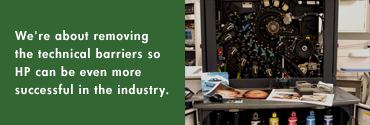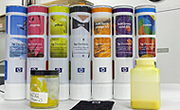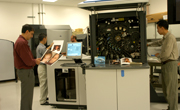
By Jamie Beckett, Jan. 2006
It was a sunny afternoon in 1999 when Eric Hanson gazed
across a conference table in Rehovot, Israel, and wondered
if he was looking at HP’s next big printing technology.
As a researcher in HP Labs, Hanson had helped develop
thermal inkjet printing technology and watched it grow
into a multi-billion dollar business. He'd seen HP's laser
printing business become a market leader.
Now he listened as engineers from Indigo N.V. described
their unique process for using digital technology for producing
high-quality, short-run prints at a fraction of the cost
of traditional offset printing.
Shortly afterward, the two companies entered into an alliance
(HP later purchased Indigo) and began the process of merging
Indigo's technology with HP's digital color printing systems
expertise. The goal: to transform the commercial printing
industry – now dominated by traditional offset lithography
presses – into an all-digital, Web-enabled business.
With that task in mind, Hanson set his team to work. One
scientist went back to school to learn how to operate a
printing press. Others investigated the machine's printing
process and color consistency. HP Labs even purchased a
press and installed it in HP's Literature Distribution
Center to compare Indigo's print-on-demand capability with
the old system of warehousing of preprinted materials.
Across the globe in Haifa, Israel, a crack team of HP
Labs mathematicians – researchers who'd already contributed
to nearly all of HP's recent scanners and cameras – began
working their algorithmic magic on improving the presses'
image quality and efficiency.
Their efforts paid off a year ago when the company released
the HP Indigo Press 5000, the first in the line to benefit
from HP Labs' innovations. These include improvements in
paper handling, color management and waste reduction, and
future generations of the presses will include much more.
The team's long-term goal is to automate as many of the
Indigo's processes as possible to lower cost, increase
speed and image quality, and simplify press operation.
"People assume that offset presses set the standard
for high-quality printing, but we disagree," Hanson
says. "If we keep pushing the technology, we think
digital will win."
How well are they doing? Here's what the respected publishing-systems experts at The Seybold Report had to say in July
2005: "Many printer manufacturers argue that their
equipment can deliver either 'offset quality' or 'almost
offset quality.' HP makes this claim in its marketing.
In the case of the Indigo 5000, we would be inclined to
agree."
Here is the story of how they got this far, and a peek
at some of what's to come.
» Unique technology
» Getting it right
» The Israel connection
» HP's press shop
» The science of great color
» What's ahead
In offset printing, ink is spread on a metal plate with
images formed in a polymer layer on its surface, then transferred
to a rubber blanket, which applies the image to paper.
Because setting up each job requires considerable time
and expense, it is most commonly used for large press runs
of items like newspapers or catalogues.
Indigo's unique technology, called Liquid Electrophotography
(or LEP), combines digital laser imaging, ultra-small ink
particles and a liquid transport system to produce prints
comparable to offset quality.
Because it is digital, the system can do short-run printing
much more cost-effectively than offset, even personalizing
each document, which is not practical with offset.
Because it uses liquid ink, it can rival offset's quality
and speed. By comparison, the dry toner (that black powder
you see when you change the cartridge on your laser printer)
used in other digital presses can be difficult to control
at high speeds.
"It's like driving on an unpaved road," says Omer Gila,
who managed color control at Indigo before joining HP Labs
in 2001. "Powder produces clouds of dust which degrade
image quality. To reduce the clouds, you have to go more
slowly. Or, on a press, you have to use larger particles."
HP Indigo presses solve this problem by containing the
particles with the surface tension of liquid ink, Gila
explains.
Yet LEP technology is not without its challenges. For
one thing, it requires so many elements – materials,
mechanical adjustments, voltages, temperatures, etc. – to
come together in exactly the right way. That means work
for the press operator, who also has to attend to paper
jams, monitor print quality, maintain the machine, and
lots more.
"When we first looked at the Indigo system, there
were more than 30 different adjustments on the paper-feed
unit alone," says Bill Holland, a researcher at HP
Labs who has been working on Indigo technology since 1999. "So
the first thing that occurred to us was to focus on improving
the ease of use and reducing the cost of the machines."
Researchers had plenty of experience developing easy-to-use
digital color-printing systems, but as Hanson puts it,
big presses were "uncharted territory."
Michael
Lee, who holds a PhD in physics, volunteered to take two
training classes for Indigo press operators. He, Holland
and others on the team poured over the Indigo service manuals
to figure out how difficult maintenance was. Researchers
scrutinized individual components of the presses, eventually
adding such functions as recycling for imaging oil, and
improving sensors for paper thickness and ink density.
In the process, they got to know the Indigo technology
very, very well.
"Labs worked on everything – the underlying
chemistry, the mechanics, the electronics, the imaging
pipeline and more," recalls researcher Keith Moore,
who joined the effort in 2004. "We're about removing
the technical barriers so HP can be even more successful
in the industry."
At the same time, researchers in HP Labs Israel were getting
to know Indigo technology in another way. Long accustomed
to working across languages, time zones and distance with
U.S. customers, the team began what became a warm and productive
relationship with their counterparts at Indigo, who were
located less than two hours away from the Haifa lab.
Scientists delighted in the spontaneity of being able
to make a quick telephone call or hop on a train to brainstorm,
test ideas and experiment.
"Having a business customer so close makes all the
difference," says Doron Shaked, who leads one of two
HP Labs Indigo research teams. "Some of us know the
presses very intimately by now."
"We speak the same language, and I don't mean just
Hebrew," adds researcher Mani Fischer. "We understand
how things happen, how the presses operate, and we understand
how we can help each other."
That closeness worked. Shaked's team contributed technologies
that make it easier for press operators to monitor and
inspect in-progress jobs and print more consistent pages.
They also provided capabilities that give customers the
flexibility to balance print speed and image quality for
best results.
A team lead by Carl Staelin, a principal research scientist
in HP Labs Israel, developed a less expensive and more
efficient method to measure color consistency and improve
print quality.
"Indigo's engineers would raise a problem they thought
we might be able to help them with, and people in our group
tried to catch whatever we could," he says.
Adds Pinni Perlmutter, chief technology officer for HP's
Indigo Division: "We feel they're a part of us. We
look at them as our algorithm group. If you need some sophisticated,
state-of-the-art algorithm to solve any problem, these
people are our first choice."
Sometimes there's no substitute for getting your hands dirty. After HP acquired Indigo N.V. in 2002, the HP Labs set up its own print shop to give researchers the ability to experiment on working Indigo presses. The shop currently houses four presses, including the HP Indigo Press 5000, and is staffed by two trained technicians who gather data, assist in analyzing it, and help to set up and run experiments.
These experiments require incredible control because each press component is interrelated, explains Paul Matheson, an electronic prepress technician (prepress is the file-preparation side of printing) who joined HP Labs in 2002.
"It's a very multi-disciplinary problem that involves electrical, physical, chemical and mechanical processes. You change one and it affects all of them," he says. "If someone is investigating the press blanket, you have to consider the paper, the temperature of the ink, the materials that make up the blanket, the chemicals in the ink – everything."
When it comes color printing, Gary Dispoto doesn't like
surprises. He wants users to get the results they expect
and he wants the color to "just work." He and
his team at HP Labs have devoted the past two years to
trying to make sure that's what happens with HP Indigo
presses.
We've all had the experience of seeing a color on our
computer screens that doesn't show up on the printout,
or seeing color differ from one printer to another. That
happens because devices differ in the range of colors they
can reproduce.
Dispoto and his team have made color management more predictable
by working with the International Color Consortium (ICC)
to establish and improve standards for color communication
and transforms. Color profiles contain the information
necessary for colors captured on one device to be reproduced
satisfactorily on others.
"We've worked a lot in this area because we're trying
to get the best possible print," Dispoto explains.
Similar thinking led to the development of CMYK (Cyan,
Magenta, Yellow, Black) Plus, a rendering technology that
makes color appear consistent across different HP printing
devices while still using each device's fullest color capability.
With CMYK Plus, users get the full, rich colors they expect
from their printer while getting consistent results no
matter what HP printer they use, explains Dispoto, whose
team contributed to the technology.
On the HP Indigo Press, CMYK Plus adapts lightness and
maximizes color saturation to make the most of the range
of colors the printer can reproduce.
By making color management more predictable, researchers
hope to help transform commercial printing into a Web-based
business. In the past, a graphic artist working on a magazine
cover would have a proof made and take it physically to
a printing shop where a press operator would adjust the
press until the printout matched the artist's proof.
"When press runs were long – that is, many
thousands of prints – it was worth it for the graphic
artist to hand-carry documents and for the press operator
to spend lots of time making adjustments," Dispoto
says. "Today marketing collateral is becoming more
personalized and short-run printing is more common. You
can't afford to have someone twiddle knobs on the press.
It has to work more automatically than it did."
Instead, the graphic artist should be able to create a
design, proof it on his or her own HP DesignJet, send it
by e-mail to the printer – and be assured that the
final product will match the proof. The ICC color management
system now has this type of capability due to the leadership
provided by HP researchers.
In the early days of HP's involvement with Indigo, Perlmutter
recalls how engineers spent a lot of time together figuring
out in which direction they wanted the technology to go.
"We looked at what areas we wanted to improve," he
says. "We talked about what our 'dream machine' might
look like."
They're still working toward that dream machine. Only
now, instead of a handful of engineers in a small conference
room, there's an entire technical community inside HP – in
Haifa and Rehovot, and in Boise, San Diego and Palo Alto – thinking
and working daily to design a digital commercial printing
system that not only beats all other digital presses, but
also beats offset.
"
We're not quite there yet," Hanson says. "But
we think we can nail it."
Jamie Beckett is managing editor of this Web site and a former reporter and editor at the San Francisco Chronicle.
|


